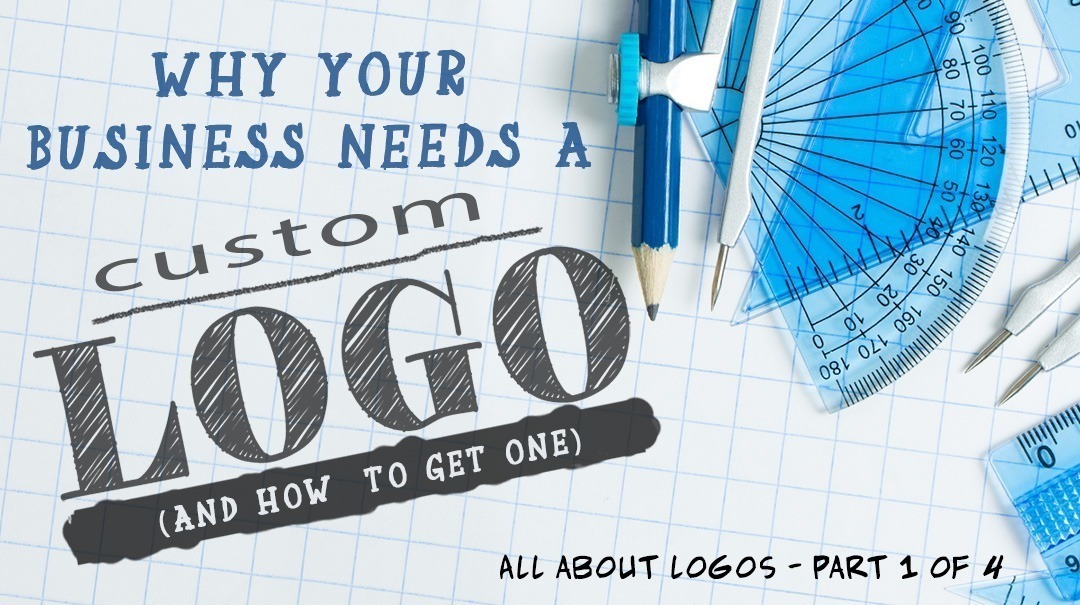If you have a company, you need a custom logo.
This should be obvious to most businesspeople. When you think of a company, you most likely think of its logo. It’s been like this for a couple hundred years. That’s not accidental. It’s not only how business works. It is how people work.
Startup 101 – basic materials you need
Almost every business startup article gives the same advice: Post-COVID, you might be able to get by without a business card. But you need a website, email address, and logo.

Every contemporary business needs to build its digital footprint from the start. What most start-up advice misses is that above that footprint is a face. Your logo is the face of your business! It is the first step toward building a brand identity. As we will see, that is critically important to developing a new company.
(Obviously, we are only talking about the startup marketing materials. Despite what you might hear on YouTube, a great website, drop-ship scheme, or online course is no substitute for a first-rate product or service. Check local sources for licensing and other requirements. The US Small Business Administration website is a great starting point.)

Groucho Marx was right: we remember what we see. His famous (or infamous) line, “I never forget a face, but in your case I’ll be glad to make an exception,” is a testament to how permanent our visual memory is.
If you are of a more literary—but no less witty—bent, Oscar Wilde wrote, “A man’s face is his autobiography.” Your logo tells the shorthand, visceral story of your business. The brief statement your logo makes about your organization is undeniable and unavoidable. This is why most companies select visual branded logos. These include the business name and an image. (Nuanced Media, 2014).
Key to using your logo to gain brand recognition is to put it everywhere. Seriously, everywhere! Use it a lot. Brand recognition is a numbers game. On average, consumers require 5-7 impressions before they recognize—and remember—a business logo (Pam Moore, 2014). Don’t be shy.

Human beings are visual creatures.
It isn’t surprising that we automatically associate the visual image of a logo with the company it represents. It’s built into every human brain. This is true regardless of age, geography, nationality, and education level. We take most of our cues for behavior from the visual world. Of course, all of our senses add to our perceptions and understanding of the world, but we learn best—or at least first—from what we see.
Humans instinctively look for visual references in the environment. Those references inform and affect us profoundly on both conscious and subliminal levels.
We all judge books by their covers
One lesson from my recent blog, 14 Things my Mom Taught Me About Business, was, “You can’t judge a book by its cover, but you probably won’t read it if it looks boring.” If your logo doesn’t accurately describe your business or is not very well-crafted, then you are probably turning away customers. They may not know exactly why they don’t want to do business with you, but that gut feeling…you just can’t shake it!
Relying on first impressions is a hardwired and vital part of the human survival instinct. Call them feelings, impressions, or gut reactions. Before the mind gets involved on a thinking level, it evaluates what the eye sees—size, shape, color, movement, texture, light, shade—and forms often unchangeable opinions. Even though our safety no longer demands we pick out the shape of fangs and claws in nearby bushes, our reliance on instant visual impressions persists.
How instant is an instant impression?
According to research by the perpetually clever 3M Corporation, humans process visuals 60,000 times faster than text. (Nuanced Media, 2014). Other studies have found that the brain “deciphers image elements simultaneously, while language is decoded in a linear, sequential manner taking more time to process.” Simple is better. That’s why a stop sign looks like this and not like the alternative below.

When we need you to stop, we need you to stop NOW, not when your brain has deciphered the type!
Why is a logo effective?
Logos are a visual shorthand that represents a company. Logos are not illustrations. They suggest but do not define.
The idea of the logo as a meaningful element is a part of worldwide consumer culture. Today, 42% of consumers say that a logo effectively conveys a company’s personality. More importantly, 50% of consumers are more likely to patronize a brand with a logo they recognize. (Study Finds, 2020).
The secret superpower of the logo
That same study also determined that 60% of consumers avoid brands with unattractive, unprofessional, or just plain weird logos. Even more shocking is that the tendency to avoid a company with an unappealing logo does not change even if that company has positive Yelp or Google reviews!
So, you need a good logo!
Where to get a custom logo?
Note the adjective I’m using there: custom. The title of this blog is Why your business needs a custom logo. The idea of “custom” is essential.
Crucial, in fact.
Non-negotiable!
Your logo must be unique. If it isn’t custom-made expressly for your business, then your logo is falling short on one of its critical missions. It cannot be a knock-off of another logo, cannot be made up of clip art, or churned out by software that assembled it from a library of icons, shapes, and typefaces.
Your business deserves better.
Your customers expect better.
You need to deliver better.
Logo sources to avoid
I get hate mail when I write this opinion. But this is not opinion. Any competent brand-oriented marketer will tell you the same thing.
Do not buy a logo from a logo generator (Wix logo maker, for example) or from cheap bidding or freelance sites, such as Fiverr or Upwork.
Why? I am not just being Mr. Cranky Pants. There is good reason to steer clear.
Avoid online bidding and talent sites.
Like other designers in the US, Canada, and Europe, I cannot compete with designers in India, the Philippines, Indonesia, or sometimes in South America, who will make a logo for $15. I don’t even try. And you should not buy them.
This is not about protecting higher-priced logos or dissing designers in developing countries. It’s about the logos’ quality and the designs’ exclusivity. As a designer working on those platforms and a consultant advising those who have used them, here’s what I found.
Most of the designers who are selling cheap are doing one or more of the following things:
-
- using clipart
- selling the same logo to multiple clients
- copying other designers on that platform
- stealing designs from established businesses
- a few sneaky “artists” use logo generators to assemble logos that they later claim to be custom-made.
In any of these cases, your logo is not custom. It is surprisingly likely that you will run into someone else using the same logo somewhere. You think it would be an uncommon occurrence, but let me tell you a few first-hand experiences:
-
- At a lacrosse tournament a couple of summers ago, I saw three unrelated teams from different states with the same logo. Team names–Eagles, Hawks, and Raptors–were in the same typeface. Each program purchased an “exclusive” logo from an artist on Fiverr. The managers of those programs were irate. Youth sports is big business, and that event tarnished some brands.
- I’ve seen several artists on Fiverr and other websites that, in the same portfolio, show the same logo graphic used for more than one company.
- Several of my startup and rebranding clients’ logos were found to be slightly edited versions of clip art found in Google searches. These were not royalty-free images, so it was a copyright violation.
- One client’s logo was composed of elements I recognized from Canva’s logo-making program. It was not custom or even designed but assembled by a few lines of code.
Don’t let this happen to you!
There are plenty of fantastic designers who can design a top-notch custom logo. You do not have to settle for second-rate, clip art-copied, or stolen designs that are a copyright lawsuit waiting to happen!
Logo generators
Logo generators like Wix, Canva, Looka, BrandCrowd, and Tailor Brands are popular choices for new businesses. An online app assembles a logo based on pre-programmed parameters and imagery. Instead of working with a live designer, the user interacts with a browser interface that might include:
-
- browsing a library of sample logos that you can modify,
- inputting keywords about your business that generate images related to them,
- or selecting from a menu of elements to arrange into a logo.
It is clip art but packaged in a way that suggests “custom” and “unique.” The end result is neither. These logos have a decidedly store-bought look.
Dress to impress
Again, one of my mom’s basic business rules [link again here] was never to go out anywhere dressed like a slob. One designer I know said that the products of logo generators vs. logo designers are like the difference between suit jackets from Brooks Brothers and Walmart. Both have buttons and pockets in the right spots and places to stick your arms and legs. However, the differences are profound. The $800 Brooks Brothers suit hangs beautifully, with bespoke sleeves tailored to fit the customer’s physique. On the other hand, the Walmart version has tubes of fabric that will fit my arms, my skinny cousin’s, and my best buddy’s beer barrel-sized appendages. And none of us very well.
What impression do you want to make?

Hire a professional logo designer
If you want good writing, hire a professional writer. If your car has a dent, find a pro at a body shop. Same goes for logos. Logos are not decorations. They are communications tools. Professional designers are experts in visual communication.
There are designers who specialize in logos. Many graphic designers do logos as part of their services. Some are very good, while others are just okay. Logo design is a quirky niche in the graphic design world. Not every designer is good at it. Review portfolios carefully before hiring anyone regardless of reputation.
Generally speaking, Designers focus on aesthetics and functionality. Branding agencies or consultants frame logos as part of an overarching brand strategy. Brand marketers’ expertise extends into messaging, operations, and content. Both professionals take different approaches to the problem may be different, but either can provide logo guides, color schemes, and other foundational elements.
Student or new designers?
Speaking as someone who was a design student, I can only say that the work I did straight out of college wasn’t nearly as good as the work I do now. That doesn’t mean it was terrible. It’s just that I’m a lot smarter now. I’ve been in business for myself and worked with organizations of all sizes, from family companies to multinational conglomerates. That experience adds to my value as a designer. I have insights (and creaky knees) today I didn’t have when I was 23.

Because I know more about business and design today, I believe—and I’m told—my work is of high quality. Some of my early designs are still in use nearly 30 years later. This longevity says something about relevance and, I think, quality.
As someone who has hired designers for three decades, I find newbie freelancers fresh out of school to be hit or miss. Some are unreliable. Others can only work at a speed measured in semesters. Business runs on tighter deadlines. Many work other jobs, so design is a side gig that gets pushed behind other things that people in their early 20s do. It all depends on the person.
Brand new designers tend to be either inexpensive for what you get or completely the opposite. Many exit design school thinking they are the greatest thing since pita bread and charge an unrealistically high fee.
That said, when I started out, somebody gave me a chance, which led to more opportunities. Your logo commission might be the project that launches a new designer to big things!
How much should a logo cost?
There is no standard price structure for anything in design or marketing. Pricing depends on so many factors that it’s impossible to predict. Fees in big cities are more than those in rural areas. Specialists cost more than general designers. Seasoned artists command a higher price than newbies.
Many designers price logos according to the size or development phase of the company. Some designers will charge an established company $500 for a logo, but a mom-and-pop startup only $150. Meanwhile, a prominent brand design firm in Los Angeles or New York sells logo designs starting at $5000 or even $20,000.
Website Planet polled new businesses and found the following about small businesses buying custom logos from a professional designer:
-
- 57% of small businesses are willing to pay $500
- 18% of small businesses will pay up to $1,000
- 14% are willing to spend more than $1,000 (Website Planet, 2021).
What does the author charge for a custom logo?
It depends! We do logos as a stand-alone project and as part of more extensive campaigns or systems. Schedule a consult here!
At my agency, we often roll the cost of logos into a more extensive brand package. That might include website design, social media programs, email marketing, comprehensive digital strategies, and other marketing and advertising services
Start out the right way. Buy a custom logo.
We’ve covered the basics of what a custom logo will do for your business. While it won’t guarantee success, a custom logo is the first step to crafting a powerful brand.
But remember that your brand is a lot more than just your logo. It’s also how you deal with customers, answer the phone, and position yourself relative to the competition. Your logo is a cornerstone of your brand identity, but it’s not everything. I wrote a detailed blog about this topic on our sister site for the Logo Design Group.
You should have an idea of why you need a custom logo and where to get one. That’s a start! The next installment of this series, Everything you need to know about logos but didn’t know who to ask, explains logo basics, so you will sound like an expert when you get into the nitty-gritty of the design process with the designer you choose.
Bibliography
https://financesonline.com/logo-statistics/
https://www.crowdspring.com/blog/branding-statistics/
https://oit.williams.edu/files/2010/02/using-images-effectively.pdf
https://research-collective.com/human-factors-history-designing-stop-sign/

About the author
Richard Williamson has enjoyed a three decade career in marketing, advertising, and public relations. Formally trained in graphic design and copywriting, he is a partner here at BackBurner Marketing and founder and lead designer of the Logo Design Group. Find out more about him here or at www.RichardWroteThis.com.
Richard is available for brand and marketing consulting, business coaching, and as a fractional Chief Marketing Officer.

